Tiffany Grade and John Cooley, Jr.
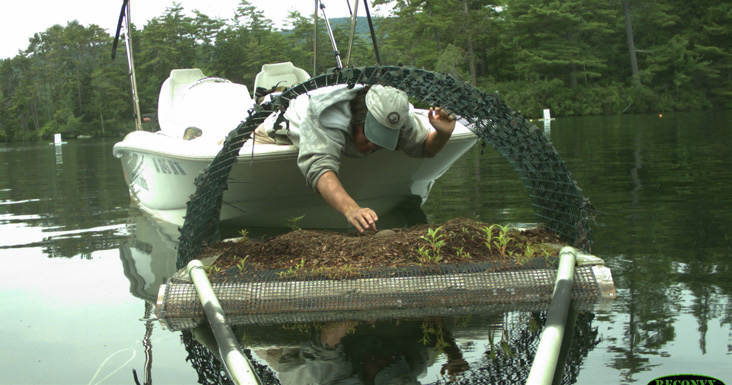
Picture 1. Loon Preservation Committee works under state and federal permits to collect loon eggs from failed nests for research purposes. A nest camera shows one of the authors collecting an unhatched loon egg from Squam Lake. Photo credit: Loon Preservation Committee.
When Shakespeare famously wrote of actors holding a mirror up to nature, he could not have imagined how well the analogy would fit the Common Loons (Gavia immer) of Squam Lake, New Hampshire. In this case, it is the loons of Squam that hold a mirror up to loons elsewhere in the state, both in their challenges and in their successes. The Squam Lake loons have been monitored and documented since 1975 by the Loon Preservation Committee (LPC), a nonprofit organization working to preserve and protect loons throughout New Hampshire. For more information about LPC, please visit www.loon.org.
The 6,800-acre Squam Lake has been a microcosm for the state for at least the last 45 years. After all, LPC was founded by Rawson Wood, a resident of Squam Lake who was concerned about the declining loon population on the lake. These declines were mirrored throughout the state, leading to LPC’s statewide efforts to protect this iconic bird. Shortly after LPC’s founding, the first documented case of lead poisoning killing a Common Loon came from Squam Lake (Locke et al. 1982; LPC unpublished data). Today, LPC continues to work to understand the challenges facing Squam’s loons.
Common Loons were listed as a state-threatened species in New Hampshire in 1979 after more than a century of population declines resulting from habitat loss, human disturbance of nest sites and breeding loons, and direct persecution. As LPC’s efforts began to pay off and Squam’s loons climbed out of the trough of those years, Squam’s loon population settled into the expected ups and downs that the vagaries of loon breeding success can bring (Figure 1). In the mid-1990s and early 2000s, the Squam Lake population was averaging 14 pairs of adults, 10 hatched chicks, and 6.6 successfully fledged chicks each year. In the banner year of 2003, Squam fledged 15 loon chicks.
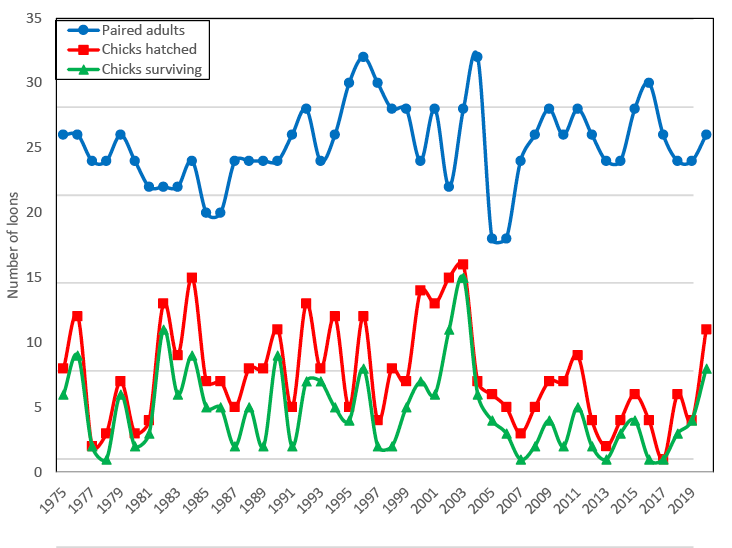
Figure 1: Loon population of Squam Lake, New Hampshire, 1975-2020.
After having 16 pairs of loons on the lake in 2004, LPC had little reason to believe Squam’s loon population would not continue to do well. But in 2005, the population dropped to only nine pairs of loons—an unprecedented 44% decline in the paired loon population, the largest single-year decline on a large lake that LPC has observed in its history. This was followed by the near-complete reproductive failure of the remaining loons, with only a single chick fledging in 2007. Although the adult population has rebounded to an average of 13 pairs since 2008, productivity has remained low. In several years in the last decade, only one chick fledged from the lake; in 2017, only a single chick hatched—a low not seen in the 45 years LPC has been monitoring Squam. Average productivity on Squam since 2007 is only half the statewide average and half the level needed to maintain a population (Figure 2).
So what happened on Squam Lake? Like loons throughout New Hampshire, Squam’s loons are facing multiple co-occurring stressors, including habitat loss, increasing disturbance from recreational activities, increasing predator populations, and climate change. But there are two threats—chemical contaminants and lead poisoning, neither unique to Squam—that, combined with these other stressors, seem to have contributed significantly to the declines in Squam’s loon population. As these threats have been identified, Squam Lake has provided a cautionary tale for New Hampshire’s loon population.
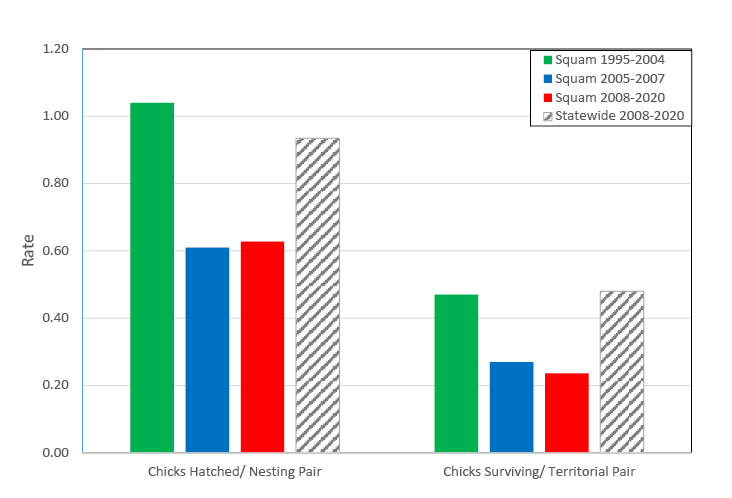
Figure 2: Productivity rates on Squam Lake (New Hampshire) compared with those for the rest of the New Hampshire loon population.
An alphabet soup of contaminants
To all appearances, Squam is a relatively well-protected lake, with 35% of its shoreline and nearly 30% of its watershed conserved (B. Wymer, Squam Lakes Conservation Society, personal communication). There is no industry and minimal agriculture and commercial development in the watershed. In short, it is not the place to expect elevated levels of chemical contaminants.
But loon eggs have told a different story. LPC works under state and federal permits to collect unhatched loon eggs from failed or abandoned nests for research purposes (Picture 1). As part of LPC’s investigation into the declines in the Squam loon population between 2005 and 2007, LPC submitted unhatched eggs for contaminant analysis—and the results were an alphabet soup of contaminants, with levels up to six times higher in eggs from Squam than in eggs from other lakes tested. Contaminants tested included polybrominated diphenyl ethers (PBDEs), which are used as flame retardants; per- and polyfluoroalkyl substances (PFAS), used in stain guards and firefighting foam; polychlorinated biphenyls (PCBs), used in industrial insulating and cooling agents; dichlorodiphenyltrichloroethane (DDT), its breakdown product dichlorodiphenyldichloroethylene (DDE), and the pesticide chlordane; and dioxins and furans, which are byproducts of industrial processes. Isotope tests indicated that the contaminants primarily came from Squam Lake rather than from the loons’ wintering ocean environment (LPC, unpublished data)—a result that was expected based on loon breeding biology and the fact that nutrients in bird eggs generally come from recent dietary uptake (Custer et al. 2010).
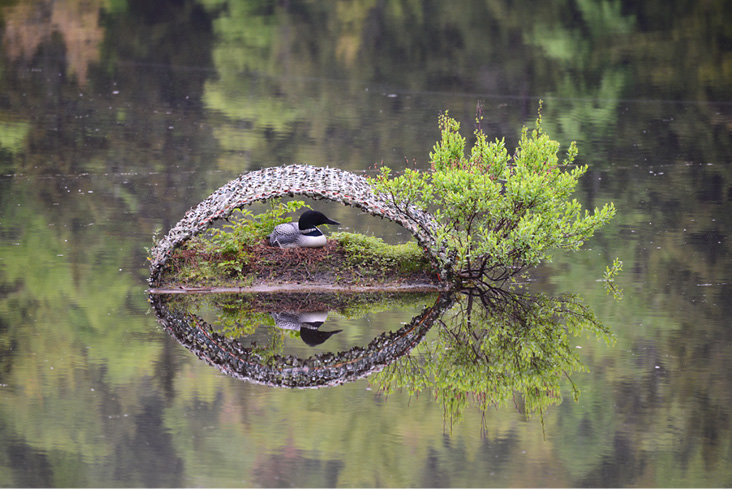
Picture 2: Rafts like this one at Pleasant Lake protect nesting loons from fluctuating water levels and shoreline predators. Photo credit: Kittie Wilson.
Further testing of eggs from the periods before and after the years 2005–2007 indicated there may have been a spike in PBDEs, PCBs, PFAS, and chlordane as well as dioxins and furans during those years, although the small sample size of eggs from this period, due to the loss of paired adults, complicates interpretation of these data. Increased runoff may account for a potential spike in contaminant levels, as LPC has found a correlation between elevated runoff and higher contaminant levels in loon eggs two years after the runoff event (LPC, unpublished data). The two-year delay makes sense, given that these contaminants bioaccumulate and biomagnify in aquatic food webs. Although overall contaminant levels on Squam Lake declined after 2007, some loon eggs from Squam continue to register elevated contaminant levels.
What does this egg contamination mean for loons? The effects of these contaminants on loons are poorly understood, although this question is an area of active research for LPC. For now, the best we can do is compare contaminant levels in loons to levels that affect health and reproductive success in other bird species. Approximately 70% of the eggs tested from Squam Lake from 1993 to the present contained levels of PBDEs and PFAS that approached or exceeded levels that are known to affect other bird species, and 41% of eggs had similarly elevated levels of DDE. Several eggs also exceeded effects levels for PCBs, and LPC is carrying out further testing and research to understand levels of dioxins, furans, and dioxin-like PCBs in loon eggs. In combination with other stressors, the apparent uptick in contaminant levels in the years 2005–2007 may have contributed to the decline in Squam’s loon population and productivity, but LPC is continuing its research to understand possible effects of the contaminants.
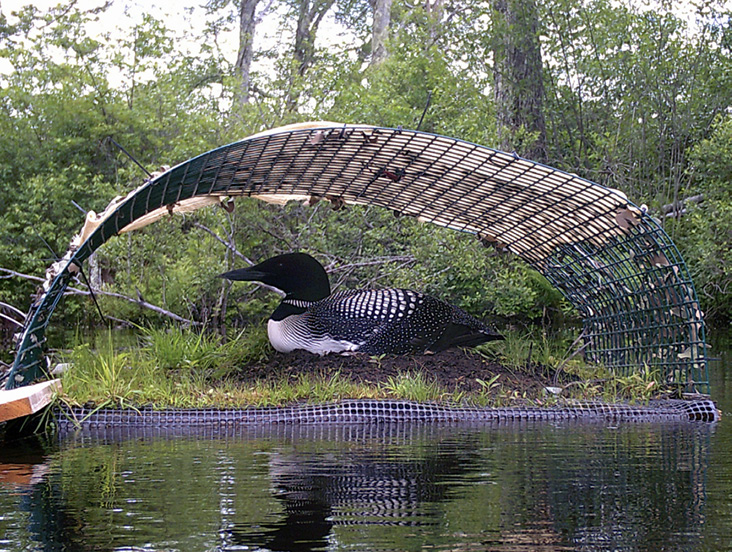
Picture 3: Loon nest rafts will be fitted with shade fabric and camouflage netting to cool the nest—a pilot version on Lake Winnipesaukee shown here. Photo credit: Loon Preservation Committee.
The question immediately arose as to the source of these contaminants within the Squam watershed. As mentioned earlier, Squam is not the lake on which one would expect to see elevated contaminants. To try to answer that question, LPC launched a sampling program focusing on areas of the lake from which the loons had disappeared between 2005 and 2007, and thus might have been expected to have had higher contaminant levels. Sampling first focused on crayfish, followed by sediments, as we worked into the tributaries that feed the lake. Realistically, this search was like looking for a needle in a haystack, so our surprise was great when we found three areas of elevated contaminants in the sediments: one for PCBs, dioxins, and furans and two for DDT. The first site was 2,900 times higher than background levels in sediments for PCBs and 140 times higher for dioxins and dioxin-like compounds. The two DDT sites were 16 and 430 times higher than background. These sites exceeded levels of sediment quality guidelines established by state and federal agencies (LPC 2017), and it is likely that there are additional contaminated areas or potential sources of contaminants in the watershed. From our initial discovery of these contaminants in loon eggs, LPC has shared its results with state and federal agencies and local stakeholders, and we are working closely with the New Hampshire Department of Environmental Services (NHDES) and local organizations to find a solution to these contaminated sediments.
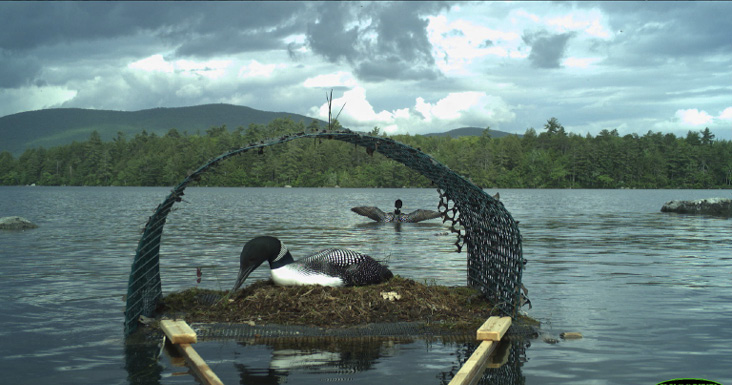
Picture 4: A nest camera shows a hopeful scene of a loon pair using one of Loon Preservation Committee’s nesting rafts on Squam Lake. Photo credit: Loon Preservation Committee.
But there was one more sample type that needed to be tested: fish. Given that loons are a fish-eating species and that these contaminants move through the food web, fish are the bridge between the contaminated sediments and crayfish we found and the loons—and the immediate source from which loons are ingesting the contaminants (along with some crayfish). But there was one other potential risk: human health. As a species high on the aquatic food web, loons are an important indicator species of the health of the aquatic environment (Strong 1990, Evers 2006). If loons were acquiring the contaminants from fish, it seemed likely that there could be a risk to humans eating fish from the lake as well.
Sampling and testing fish from Squam Lake for PFAS and PCBs were carried out by NHDES. Early in 2020, the results came out: NHDES was issuing new, more stringent fish consumption guidelines based on elevated levels of PCBs (NHDES 2020). Like many lakes in New Hampshire, Squam already had fish consumption guidelines due to mercury contamination, but the PCB guidelines are much more restrictive. This outcome seems like the ultimate case of loons as indicator species—not just for the health of the aquatic environment and other wildlife, but for people as well.
Let’s “Get the lead out!”
At the same time Squam’s loons were dealing with a possible influx of chemical contaminants, they were also dealing with an increasing threat from another source—lead fishing tackle. As will be discussed below, lead fishing tackle is the leading documented cause of adult loon mortality in the state (Grade et al. 2018). On Squam Lake, the rate of lead tackle mortality nearly doubled in the years after 2001—the year the public boat launch on Squam was refurbished, resulting in an increased number of boats and fishing tournaments on the lake. While correlation is not causation, this increased fishing pressure is a potential mechanism to explain the increase in lead tackle deaths among Squam’s loons after 2001.
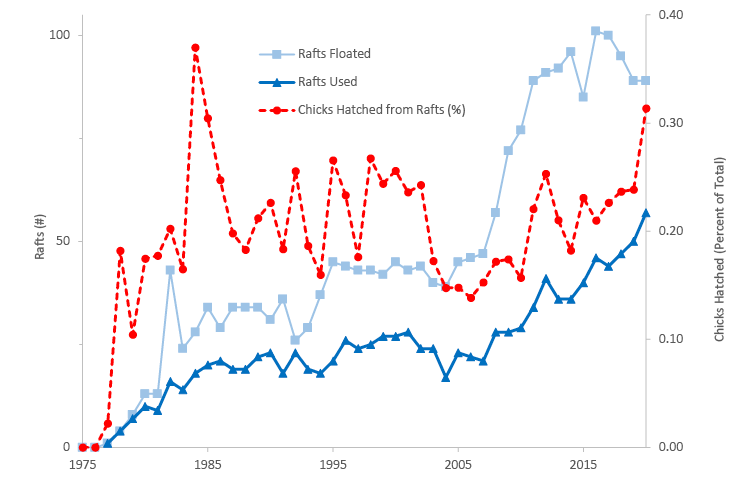
Figure 3: Over four decades of loon nest raft use in New Hampshire accounts for a fifth of all chicks hatched in the state, on average, and reached record levels in 2020. Note secondary vertical scale for the proportion of chicks hatched from rafts.
“Social chaos” among Squam’s loons
A population can only take so much. The combination of stressors facing Squam’s loons—from increased mortality due to lead fishing tackle to a possible influx of chemical contamination to increasing recreational and predation pressures to climate change—seems to have created the perfect storm on Squam, potentially leading to the population collapse in 2005–2007. But the effects were not isolated to those years. Loons are a long-lived species with a lifespan of at least 25–30 years and a protracted life history strategy (Paruk et al. 2021). Perturbations in their environment cast a long shadow over a loon population, and it takes them a long time to recover.
The loss of so many paired adults in 2005 created a vacuum in Squam’s loon population, and elevated rates of mortality from lead fishing tackle and other anthropogenic causes contributed to losses in the population as well. These gaps were filled by loons from the floater population—loons from other lakes that did not have territories. While these new birds were necessary to restore Squam’s adult loon population, the result was chaos in the loons’ social structure, with loons fighting over territories that either had chicks or had produced chicks the previous year. These fights disrupted incubation and often resulted in nest failures, and intrusions into territories with chicks sometimes resulted in the deaths of the chicks. This social chaos seems to have contributed to the poor productivity of Squam’s loon population in the years after 2007.
A cautionary tale for New Hampshire’s loons
Squam’s situation may appear to be unique—the rare perfect storm. But the threats that shaped the storm are common across the state. While the concurrent uptick in lead tackle mortality and contaminant levels on Squam, in concert with other stressors, may have been the tipping point that contributed to the decline in Squam’s loon population, these challenges are hardly unique to Squam’s loons, and they threaten loons throughout the state.
The danger of lead fishing tackle to loons and the loon population in New Hampshire is significant. A single lead split shot sinker will kill a loon in two to four weeks after ingestion (Pokras and Chafel 1992, Sidor et al. 2003). In a study of lead tackle mortality between 1989 and 2012, LPC found that the state’s loon population could have been as much as 43% higher at the end of the study period if the loons that died of lead poisoning had survived to continue reproducing. This study documented that mortality from lead fishing tackle has significantly inhibited the recovery of loons in New Hampshire (Grade et al. 2018).
As of 2016, New Hampshire law prohibits the sale and freshwater use of jigs and sinkers weighing ≤1 oz., and LPC has a lead tackle buyback program (see www.loonsafe.org) to remove lead from use and encourage anglers to make the switch to non-lead tackle. Reducing lead tackle mortality is critical for the recovery of the New Hampshire loon population—and for Squam’s population as well.
Squam is also not unique in its cocktail of chemical contaminants. LPC has tested unhatched loon eggs from failed nests from 24 other lakes, encompassing 29 loon territories, in New Hampshire. With the exception of levels during the apparent spike on Squam in 2005–2007, these lakes have similar overall contaminant levels to eggs from Squam, although some contaminant classes, notably PBDEs, remain higher on Squam. Some other New Hampshire lakes also stand out for elevated levels of certain contaminants: Canobie Lake and Lake Winnipesaukee for PFAS and Lake Francis and Merrymeeting Lake for PCBs.
In short, Squam Lake holds up a mirror to other New Hampshire lakes for the challenges facing its loon population, and perhaps Squam has showed us how close to the tipping point the loon population may be. Squam Lake tells a cautionary tale for all of New Hampshire’s loons.
Recovering New Hampshire’s loon population
As we look outward to the rest of New Hampshire and beyond, lessons learned on Squam Lake are a source of caution but also a case study in resilience. The incremental, ongoing recovery of the state’s breeding population since the 1970s has involved a sustained effort of protection and outreach. Although loon abundance remains well below the natural upper limit of available habitat or carrying capacity, and depends on continued management, the population has more than tripled since the 1970s (LPC, unpublished data). After four decades, the biggest mysteries about loon biology and the threats affecting the population are still unanswered. Nonetheless, proven methods for mitigating some threats and boosting the pace of recovery are now well understood on Squam and elsewhere. When a local population approaches the tipping point, and as the fundamental threat of climate change becomes ever clearer, we now have the benefit of this knowledge to let us anticipate and adapt.
Beginning on Squam in 1977 and since then extending to over 100 other lakes, the most familiar way to help Common Loons in New Hampshire has been to float an artificial nest platform, or raft (Picture 2). These platforms mimic the loon’s preferred natural nest on a tiny island or floating bog mat, locations that are buffered from shoreline predators and flooding. Rafts improve nesting success by as much as 50% at failure-prone sites (Desorbo et al. 2007), and raft deployment has become an annual ritual for a grassroots network of LPC field staff and loon volunteers throughout New Hampshire. As loons slowly recolonize suitable lakes and breeding sites vacant since the declines of the last century (Kuhn et al. 2011), the success-boosting fleet of nest rafts has also expanded to mitigate nest failures and degraded habitat. In 2020, for example, a record number of nesting pairs used rafts (57, including seven on Squam), and almost a third of loon chicks hatched in the state came from raft nests (Figure 3).
But this tried-and-true technique now has a new, forward-thinking design twist. Rafts are exposed to the full extent of summer sun, so the incubating loon and eggs are especially vulnerable to heat stress. To mitigate, in 2021 raft nests on Squam and other lakes will feature an added layer of shade fabric and camouflage netting over the nest to keep it cool (Picture 3). The added shade may lower the temperature by only a few degrees, but that difference could give raft-nesting loons a few more decades, on average, of suitable climate at the southern edge of their breeding range as summer temperatures continue to warm. As the complex of loon stressors on Squam has made clear, even modest measures to alleviate individual factors such as heat stress are worthwhile in the effort to stave off more catastrophic tipping points.
Hope for the future
The year 2020 brought encouraging news for Squam’s loon population: eight loon chicks fledged from the lake, the highest number since 2003. All eight hatched from nesting rafts floated by LPC and were protected by LPC’s ropes and signs (Picture 4). Early summer on the lake brought very little fighting among the loons, as many of the pairs settled quickly and quietly onto their nests. We hope the loon population is stabilizing after the long shadow cast by the perfect storm that overtook Squam, and that LPC’s efforts to support and recover Squam’s loons will continue to pay off with increased adult survival and successful nesting. With these efforts, we are working to ensure that Squam will reflect a recovering and successful loon population across New Hampshire, resilient to both familiar and emerging threats.
Literature cited
- Custer, C. M., B. R. Gray, and T. W. Custer. 2010. Effects of egg order on organic and inorganic element concentrations and egg characteristics in Tree Swallows, Tachycineta bicolor. Environmental Toxicology and Chemistry 29:909–921.
- Desorbo, C. R., K. M. Taylor, D. E. Kramar, J. Fair, J. H. Cooley, D. C. Evers, W. Hanson, H. S. Vogel, and J. L. Atwood. 2007. Reproductive advantages for Common Loons using rafts. Journal of Wildlife Management 71:1206–1213.
- Evers, D. C. 2006. Loons as biosentinels of aquatic integrity. Environmental Bioindicators 1:18–21.
- Grade, T. J., M. A. Pokras, E. M. Laflamme, and H. S. Vogel. 2018. Population-level effects of lead fishing tackle on Common Loons. Journal of Wildlife Management 82:155–164.
- Kuhn, A., J. Copeland, J. Cooley, H. Vogel, K. Taylor, D. Nacci, and P. August. 2011. Modeling habitat associations for the Common Loon (Gavia immer) at multiple scales in northeastern North America. Avian Conservation and Ecology 6(1): 4. http://dx.doi.org/10.5751/ACE-00451-060104
- Locke, L. N., S. M. Kerr, and D. Zoromski. 1982. Lead poisoning in Common Loons (Gavia immer). Avian Diseases 26:392–396.
- Loon Preservation Committee (LPC). 2017. Contaminated sediments in Squam Lake Tributaries, 2015–2016. Moultonborough, New Hampshire. https://loon.org/lpc-work/squam-lake-study/
- New Hampshire Department of Environmental Services (NHDES). 2020. NHDES issues new fish consumption advisory for Squam Lake. High levels of polychlorinated biphenyls (PCBs) detected in fish tissue. March 27, 2020. https://www.des.nh.gov/news-and-media/nhdes-issues-new-fish-consumption-advisory-squam-lake-high-levels-polychlorinated.
- Paruk, J. D., D. C. Evers, J. W. McIntyre, J. F. Barr, J. Mager, and W. H. Piper. 2021. Common Loon (Gavia immer), version 2.0. In Birds of the World (P. G. Rodewald and B. K. Keeney, Editors). Cornell Lab of Ornithology, Ithaca, NY, USA. https://doi.org/10.2173/bow.comloo.02
- Pokras, M. and R. Chafel. 1992. Lead toxicosis from ingested fishing sinkers in adult Common Loons (Gavia immer) in New England. Journal of Zoo and Wildlife Medicine 23:92–97.
- Sidor, I., M. Pokras, A. Major, R. Poppenga, K. Taylor, and R. Miconi. 2003. Mortality of Common Loons in New England, 1987 to 2000. Journal of Wildlife Diseases 39:306–315.
- Strong, P. I. V. 1990. The suitability of the Common Loon as an indicator species. Wildlife Society Bulletin 18:257–261.
After earning a Ph.D. in medieval history, Tiffany Grade realized bird conservation was her real passion and completed a master’s degree in conservation biology at the University of Wisconsin–Madison. She began working for the Loon Preservation Committee in 2008 as Squam Lakes Biologist, leading LPC’s intensive research, monitoring, management, and outreach efforts to understand the causes of the declines in Squam’s loon population and restore a healthy population of loons to the lake.
John Cooley, Jr. is a senior biologist with the Loon Preservation Committee and has coordinated LPC’s field program since 2005. After a first encounter with loons on a canoe trip in Quebec, his introduction to their ongoing recovery in New Hampshire came through a graduate program in conservation biology at Antioch New England in Keene, New Hampshire.